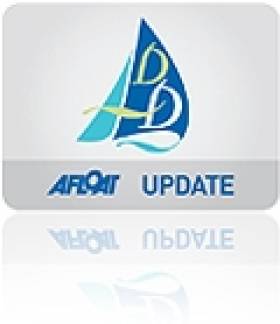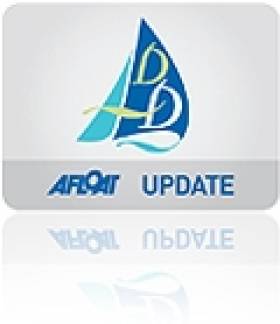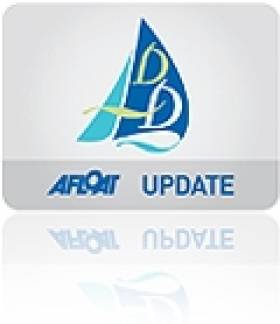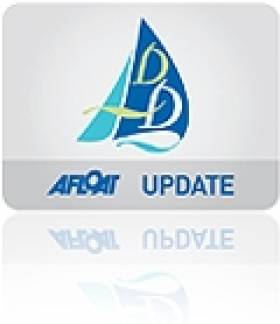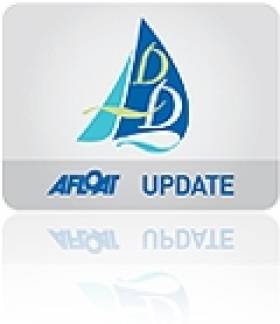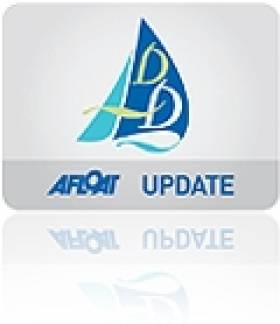Displaying items by tag: Dun Laoghaire to Dingle
#D2D – Finishing shortly after 3am, a County Kerry entry, Amazing Grace, won the 2013 Dun Laoghaire to Dingle race, the first Kerry yacht to win in the 20–year history of the race. The Tralee Bay Sailing Club entry, one of the slowest, oldest and heaviest boats in the race was sailed impressively by a Fenit crew and skippered by Brian O'Sullivan to beat some of Ireland's top offshore racers.
Overall results for the 2013 Dun Laoghaire to Dingle race are here. Full race report in Summer Afloat magazine published late June.
While a few boats in the 22–boat fleet have yet to finish this morning, only two of them have lower ratings and are now too far behind to affect Amazing Grace. Official confirmation of the result is expected by the race organisers later this morning.
Second overall looks likely to go to Spindrift, a Hallberg Rassy 34 under the command of David Kelly of Waterford Harbour Sailing Club, which should correct to about an hour behind Amazing Grace, while Lulla Belle, Liam Coyne and Brian Flahive's First 36.7 from the National Yacht Club, will be about an hour further back in third place.
Lulla Belle is also the winner of the double-handed division.
This was a race that favoured lower rating boats as the light winds experienced for all but the latter stages didn't allow the higher handicappers to generate the necessary distance to save their time. Additionally, the wind continued to build after the first finishers, allowing the smaller boats to cover the last 60 to 70 miles at speeds equalling or exceeding that of their faster competitors.
The south coast turned out to be a turning point for Amazing Grace, skipper Brian O'Sullivan informing Afloat.ie:
"Most of fleet sitting off south coast, looking for wind pockets! Excellent day/night to be out on the water. All to play for, with half the race more or less completed! Moved south a little to get the first break in the wind, keeping fingers crossed! Wouldn't be any place else, other than the snoring from down below, all is good!
Once again D2D, a half Round Ireland, has thrown up an interesting set of conditions resulting in an outsider's victory that will not only entice many of the entrants to return in 2015, but should also attract first timers.
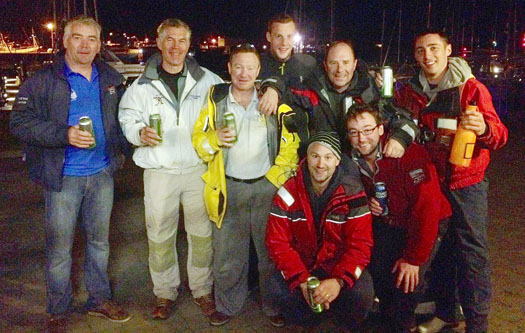
Celebrating in the early hours at Dingle Harbour the winning Amazing Grace crew are back row (left to right) Finbarr O'Connell, skipper Brian O'Sullivan, Fergus Kelliher, Pearse Boyland, Tim Kelliher, Cian O'Donnell. Front row Brendan Culloty and Michael McCormack. Photo: Frances Clifford
Amazing Grace, an Oyster 37 was built from a kit by Cork sailor Jim Fegan on a farmyard in the 1980s.
A past Round Ireland and Fastnet race competitor this offshore campaigner previously sustained damage to her rudder in heavy weather off Wexford.
Little was heard of this Oyster until she was bought by former owner Gary Horgan and raced out of Kinsale for a number of years before moving to Fenit in County Kerry under Gerard O'Donnell.
O'Sullivan bought the boat in March this year from O'Donnell and this morning's result is a highlight of her 30–year career.
O'Sullivan is a well known boat builder producing among others the 1720 sportsboat. He is managing director of O'Sullivan Marine, a leading Irish boat builder based in Tralee.
This afternoon the Tralee Bay Sailing Club Commodore Pat Daly congratulated O'Sullivan and the crew of Amazing Grace on their 'historic' win.
'This victory, by Amazing Grace, a first for a local boat, will further boost this week's ICRA National Cruiser Championship & WIORA Regional West Coast Championships, to be hosted by the club'
The club expect 500 sailors and over 60 boats to hit Fenit for four days of racing from Wednesday to Saturday, June 12-15th in Tralee Bay'.
#D2D – As the crews of Antix and Wow enjoy the hospitality in Dingle tonight the lowest rated boats are enjoying the limelight of podium potential as they close on the finish line. See D2D race tracker here
Tralee Sailing Club's Amazing Grace is in pole position with a little bit to spare and will be hoping that the wind remains steady in strength and direction over the remaining thirty miles so that they can maintain their advantage over David Kelly's Spindrift (Halberg Rassy 34).
Meanwhile Spindrift has to watch over her shoulder, but the real battle seems to be for third place between Lula Belle (Beneteau First 36.7), Polished Manx (Sigma 38) and Mojito (J109).
While the result might be seen as a testament to the durability of older designs, once the wind died mid-race it was always going to be a low handicap benefit. Mojito and Lula Belle have done well to stick with the leaders.
All things going well over the last few hours, Dingle will be feting a Kerry win in the small hours.
Dun Laoghaire Dingle Race Start Images by Aidan Tarbett
#d2d – As the leaders approach the final mark on the Dun Laoghaire to Dingle Race course, the Washerwoman Rocks, it looks like game set and match to the low handicappers.
View D2D Race Tracker Here.
Afloat.ie's current prediction is line honours for O'Leary father and son on Antix, followed by Georges Sisk's WOW, but there is going to be a close battle for the overall prize between the veteran Oyster 37 Amazing Grace under the command of Brian O'Sullivan, and Blue Eyes, the Elan 340 entered by Simon Knowles and Colm Buckley, with the double-handers Liam Coyne and Brian Flahive on Lula Belle rounding off the top 3.
The Amazing Grace crew from Tralee Bay will be hoping that their slightly longer waterline can see off the Howth challenger and deliver a Kerry win when they cross the finish line just before dawn on Monday.
Brian O'Sullivan texting Afloat.ie this evening: 'Still going well enough inspite of the relatively calm conditions. A greay day to be at sea! Praying for that freshening breeze on our own turf up along the west coast'.
Pre-race favourites Antix, will do well to finish in the top ten as the wind continues to build giving the slower boats still on the water an increasingly favourable following breeze that will see a lively spinnaker run into Dingle.
Of course, we all know that predictions can be notoriously fickle, like the weather itself, and this is all based on error free final watches aboard our nominees.
Afloat.ie will stay with the fleet and will bring the next update around midnight.
D2D Update – Lack of Wind Throws Predictions Awry
#D2D – As dawn breaks on the 2013 D2D fleet, the lack of wind throws predictions awry and observers can only wait, like the frustrated crews, for a reasonable breeze to fill in.
That might well be later this afternoon, but fickleness is still part of the equation and while the tracker shows positions, until the first boat crosses the Dingle line all bets are off.
If and when the wind fills, it seems likely to be a following breeze and this could well benefit the lower rated boats - if they can carry the new wind to the finish.
Another hard day and night ahead for most boats – a finish is not now likely until the wee hours of Monday morning for the fast boats and it could well be sometime on Tuesday for the lowest rater – Kuba Szymanski's Polished Manx, a recent ISORA race winner from the Isle of Man.
D2D Update - First 24 Hours & Two Hander Sets the Pace
#d2d – The first 24 hours of this year's Dun Laoghaire to Dingle have been atypical as the fleet juggled with the complexities of a building springtide, and relatively light north easterly winds. See live Tracker here
Most opted for the port gybe offshore option down the Irish Sea, taking them away from the stronger tides around Wicklow Head,
before gybing back inshore. Antix led the fleet around the Tuskar shortly before 4am in a relatively fresh 16 knots, but are now running downwind in a more modest 8 knot north easterly.
While Antix leads on the water, they are trading places for the overall IRC lead with Liam Coyne and Brian Flahive in Lulabelle. This is impressive going by the duo, keeping ahead of most of the fully crewed yachts. These pair are being closely followed by Liam Shanahan's J109 Ruth and Brian Carroll's Elan 40 Chancer.
With 130 miles to go the current rate of 7 knots should see Antix get to Dingle at about 10am Sunday, however, maintaining that progress may be difficult with the current forecast predicting even light winds ahead.
So all to play for over the next 24 hours, and plenty of sunshine and spinnaker work for the crews as they approach the iconic Fastnet Rock.
One time leader the J109 Mojito is stll chasing sistership Ruth. ISORA commodore Peter Ryan on board Mojito texted - 'Chasing Ruth! Hard to stick with her. Hard work. Gybing not paying. We have another plan if the wind holds'.
Brian O'Sullivan of Tralee's Amazing Grace text to say: 'We took a chance and ran the rhumb line from the kish bank and that has paid off! We' re now back in this race after a sluggish start'.
Text updates to Afloat.ie: 0n 086 7290901
#D2D – Third out of Dublin bay, ISORA commodore Peter Ryan and ISORA champion Stephen Tudor on board Peter Dunlop's J109 Mojito are the early IRC leaders an hour into the Dun Laoghaire to Dingle race this evening. See D2D race tracker here.
Scroll down for race start photos by Michael Chester.
As forecasted, it was slow progress after the start at 4pm. Some of the 22–boat fleet were still negotiating Dalkey Sound, hugging the Dublin coast to avoid the worst of the last of an adverse tide at 5pm.
Spinnakers barely filled as back markers sailed perilously close to the Bulloch harbour shore while on the water leaders Antix, Aquelina and Mojio enjoyed a few knots more from the north easterly breeze on port gybe in Killiney Bay.
The fleet was reduced by one with the withdrawal of the double-handed Blackjack but a very late entry 'Desert Star' of the Irish Offshore Sailing School based in Dun Laoghaire has taken her place.
By 6pm those still in Dalkey Sound elected to anchor such was the strength of the north going tide pushing them backwards not forwards on their 320-mile voyage.
Follow the progress of the fleet on the live D2D race tracker here and this handy link to all Afloat's D2D race coverage. We're using #d2d on race tweets.
Check back regularly for D2D race updates on Afloat.ie

Anthony and Peter O'Leary ready for the off in Scotsman's Bay this afternoon. Photo: Michael Chester.
Scroll down for more photos below in the gallery

Just 320 miles to go! The fleet leave Dublin Bay bound for Dingle on the D2D race. Photo: Michael Chester.
Scroll down for more photos below in the gallery
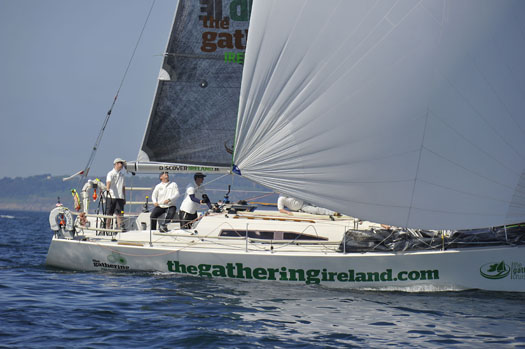
Discover Ireland, the defending D2D champions, in race mode. Photo: Michael Chester.
Scroll down for more photos below in the gallery
#d2d – Boosted by a late entry the 23-boat Dun Laoghaire to Dingle fleet are assembling this morning at the National Yacht Club pontoon in Dun Laoghaire readying for this afternoon's 4pm start. The tenth anniversary edition of the offshore race looks like it will be off to a slow start with light winds forecast to the Tuskar at least.
Pundits are backing Rockabill, the Corby 33, as a front runner but there's a varied fleet and some tested offshore campaigns all heading west this evening too. Read WM Nixon's race preview here.
The National Yacht Club race start is viewable from the East Pier in Dun Laoghaire. Follow the progress of the fleet on the live D2D race tracker here and this handy link to all Afloat's D2D race coverage. We're using #d2d on race tweets.
Dun Laoghaire to Dingle Start Photos
National Yacht Club Hosts Offshore Sailing Talk
Sailing offshore? The National Yacht Club is staging an 'Introduction to Offshore Racing' evening next Saturday 7th April 2011 at 19.30 and a line up of speakers inlcudes Maurice 'Prof' O’Connell on winning the 2009 Dun Laoghaire to Dingle Race. Mick Liddy on how to prepare for offshore sailing. Former National Yacht Club commodore Peter Ryan will give tips on ISORA racing in the Irish Sea.
Whether you are a Round Ireland expert or an offshore newbie the Dun Laoghaire club stresses it is an informal night but a 'unique one' both for offshore sailing fans and those who might be considering going offshore for the first time this season.
All the latest ISORA News
All the latest ICRA News
All the latest La Solitaire du Figaro News
All the latest Round Ireland News


























